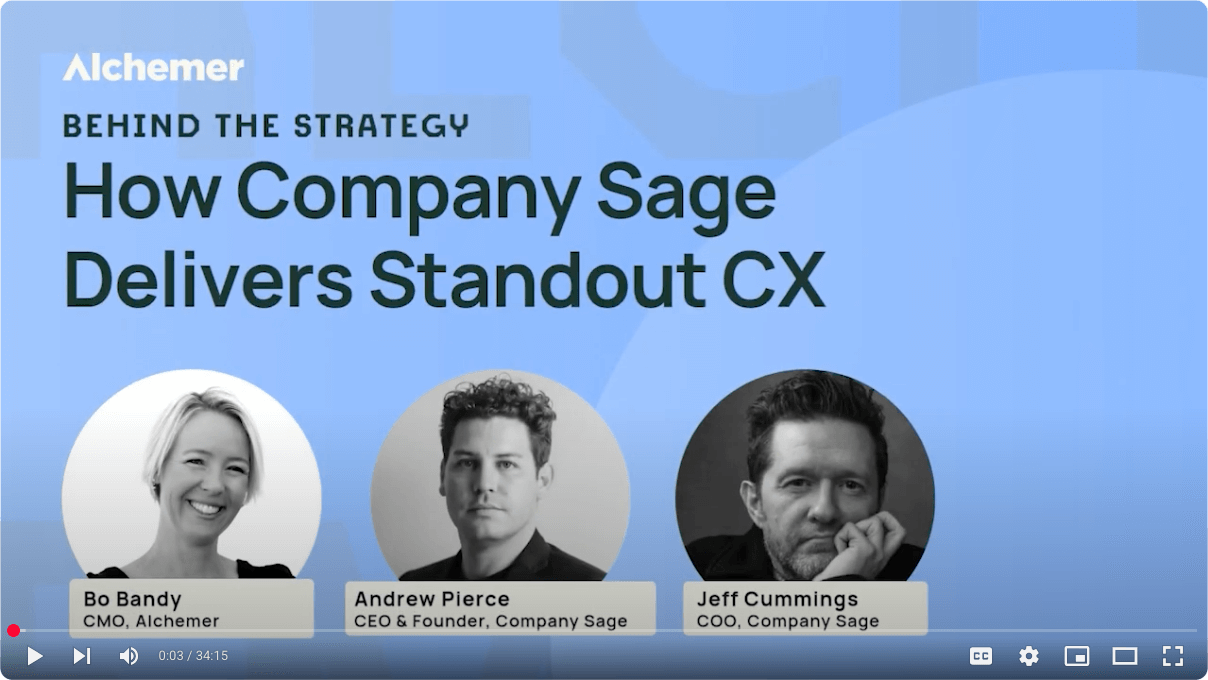What does it really take to build a business around customer experience?
In a recent episode of Behind the Strategy: CX Leadership in Action, Alchemer CMO Bo Bandy sat down with Company Sage CEO Andrew Pierce and COO Jeff Cummings to unpack how they’ve turned CX into a strategic advantage.
Company Sage helps entrepreneurs and small businesses start, manage, and grow their companies, handling everything from entity formation and compliance to back-office support. With more than 80,000 customers and a fast-growing SaaS platform, they’ve built their success not just on operational excellence, but on a company-wide obsession with treating customers right.
From real-time NPS follow-up to transparent team communication, here are six lessons from their playbook that any CX leader can apply.
Lesson 1: Start with culture
Company Sage didn’t launch with a polished strategy. They started by simply being kind to customers.
“I didn’t want to be mean to clients on the phone,” Andrew said. “So we over-delivered.”
That basic principle—treat people well—grew into something more powerful. The team realized that while their larger competitors treated customers like numbers, they could stand out by being personal, responsive, and transparent.
Today, customer experience is one of three strategic lenses for the business, alongside scalability and compliance.
Lesson 2: Operationalize feedback early and often
Company Sage’s NPS program isn’t an annual box to check. It’s a living system that drives action.
Instead of blasting all 80,000 customers at once, they send surveys in rolling batches to keep the workload manageable. Every detractor or comment with negative sentiment creates a case in Salesforce. Their support team personally follows up, logs the conversation, and shares insights with leadership.
This approach helps the team spot issues early, respond quickly, and turn frustration into loyalty.
Lesson 3: Let the data challenge your assumptions
Tough feedback isn’t always easy to hear—but it’s essential.
Andrew shared how a switch from annual to monthly billing, which seemed customer-friendly on paper, was met with overwhelming negative feedback. “We thought we were doing the right thing,” he said. “The survey results told us otherwise.”
Other surprises? Customers didn’t care about hold times as much as they cared about getting their questions answered on the first try. And small changes in mail pricing sparked major backlash that wasn’t obvious until the NPS results came in.
Lesson 4: Share feedback across the entire organization
At Company Sage, feedback doesn’t stay hidden in dashboards. It’s shared company-wide.
Survey insights are discussed in weekly ops meetings, reviewed in all-hands calls, and used to prioritize product roadmaps. Teams are encouraged to face the tough stuff and take ownership.
“If we’re not a culture-first company, we can’t be a customer-first company,” Jeff said. One team member, after hearing tough feedback, told her team: “We’re owning this. It’s never coming up again.”
That transparency keeps everyone connected to the customer and accountable for improving the experience.
Lesson 5: Close the loop and keep it closed.
Every round of NPS is followed by a summary of what the team is doing differently as a result. If a customer didn’t fill out the last survey, they get a little FOMO when they see real changes being made and they’re more likely to respond next time.
Even internal teams benefit. By tying customer feedback to changes in process or product, employees can see the impact of their work. That alignment keeps morale high and focus sharp.
Lesson 6: Keep evolving or fall behind
“Customer experience isn’t a destination,” Jeff said. “If we offer the same level of service next year, it’ll feel like a drop.”
That’s why they’re constantly looking for ways to improve. They’re using integrations to route feedback in real time. They’re exploring session monitoring tools to trigger intercepts when customers show signs of frustration. And they’re watching trends closely—like the sudden rise in mobile requests that no one mentioned two years ago.
The goal is to stay close to what customers want, not just what the company thinks they want.
Watch the full conversation
For more CX insights, listen to Andrew, Jeff, and Bo’s full conversation in the this episode of Behind the Strategy: CX Leadership in Action.
Looking for more CX guidance?
Check out additional Behind the Strategy episodes or download The CX Leader’s Guide to the CFO for help aligning your feedback program with business goals.


